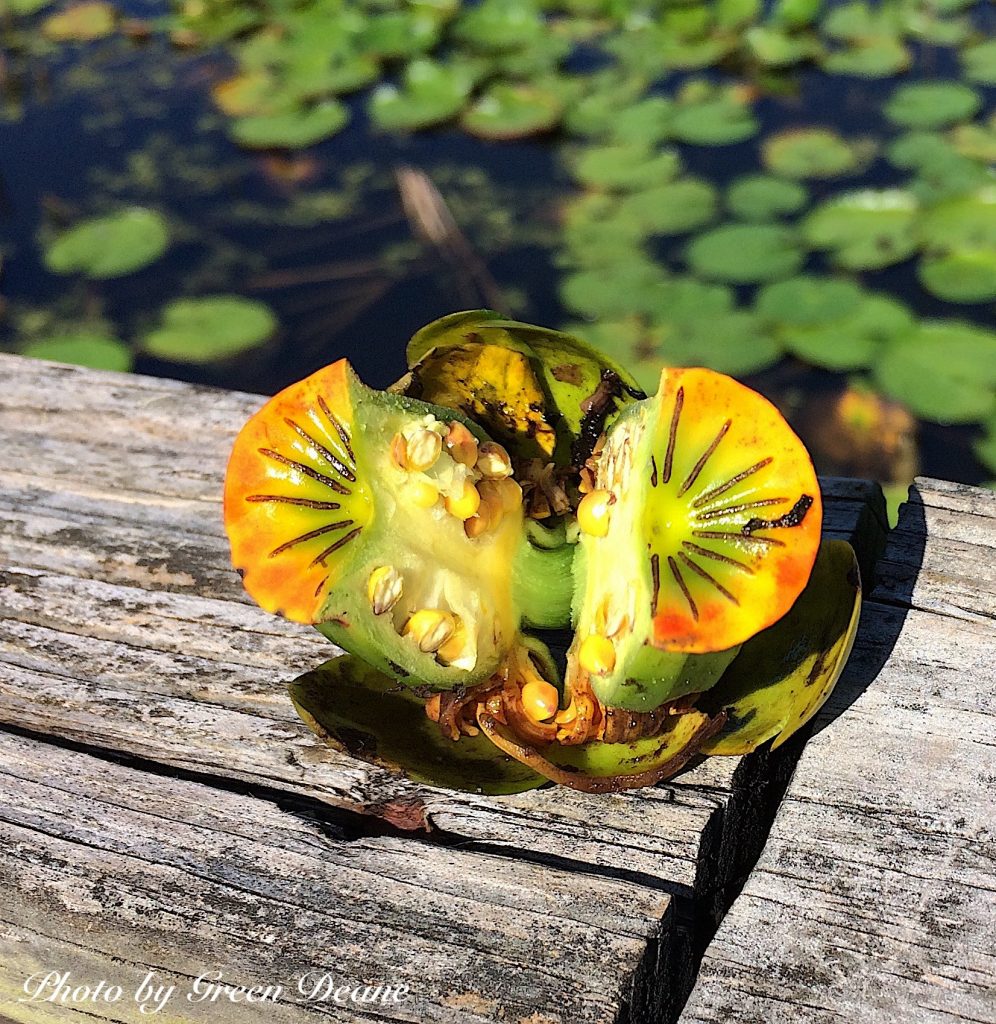
Yellow Pond Lily seeds resemble corn kernels. Photo by Green Deane
This might be a good time to write about Yellow Pond Lilys. While they fruit rather continuously the pond residents are putting forth a fall crop now. Plants may not have a brain they can have a strategy, or at least so it seems. Many of them protect their seeds in various ways until they are ready to germinate. The Persimmon Tree comes to mind. The fruit is astringent until the seeds are mature enough to germinate. Then the fruit turns sweet attracting various animals to eat it — those that can taste sweet — and spread the seeds around. The Yellow Pond Lily works in a similar fashion. Seeds that are not ready to germinate are bitter. As the plant dies the floating seed pod rots over a three week period. When the seeds are ready to germinate the protective bitterness is removed by enzymatic action. This makes the seeds also edible. Of course we humans can take advantage of the system by collecting the seed pods ourselves and controlling the rotting process. Then we get the seeds and dry them for use in various ways. You can read more about the Yellow Pond Lily here.
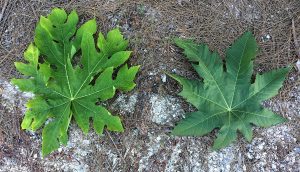
Papaya leaf on left, Castor Bean on right. Photo by Green Deane
Many botanical terms can be confusing among them palmate and pinnate. We’ll address pinnate another time. Palmate shouldn’t be difficult but it can be. It means shaped like your hand but… there are small grape leaves that are “palmate” and about the size of an adult hand. Then there are palmate leaves that are a foot across. Here are two, one from the edible Papaya tree and the other from the deadly Castor Bean. The papaya leaf, on our left, is palmate with lobes. It has seven sections, seven main veins and two sections on the bottom. Stem attachment is on the edge. The Castor Bean, right side of the photo, is also palmate but has eight sections, the sections have teeth, eight main veins total, and three sections on the lower side. Stem attachment is not on the edge. There’s more about the Papaya here.
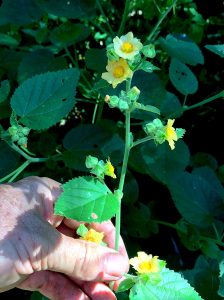
Sida cordifolia. Photo by Green Deane
Is it Sida (SEE-dah) or is it Sida (SIGH-dah)? Either either it would seem… There are several members of the Sida genus locally and they blossom nearly all year. This weekend, however, Sida cordifolia was particularly happy on the central west coast of Florida in Largo. Taller and softer than some of the other genusmates, it’s a plant with a little bit of legal history. Plants in the genus tend to have ephedrine in them to varying amounts. Sida cordifolia, however, is the only Sida species mentioned in the Florida Statutes. If you make a pill using the plant it cannot be given to anyone under the age of 18. I doubt the problem is bootleg diet pills but rather youthful experimenting with ephedrine. Adults can apparently do what they want with the plant. S. cordifolia is not native. The species I see the most often is S. rhombifolia, which means diamond shape. The lower part of the leaves of that speices do not have teeth on them. You can read more about Sida here.
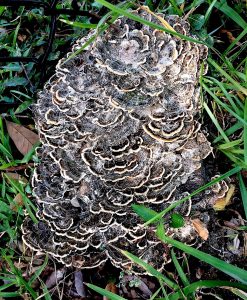
True Turkey Tails. Photo by Green Deane
And what of Turkey Tails? Turkey Tails are fairly easy to identify medicinal mushrooms. We spied some on our foraging class in Largo. For a common type of mushroom I don’t see them that often… two or three times a year. I see False Turkey Tails far more often. More on that later. A seven-year study funded by the National Institutes of Health found Turkey Tail (Trametes versicolor) boosted the immunity in women who had been treated for breast cancer. Researchers at the University of Minnesota and Bastyr University conducted the study in women with stages I-III breast cancer who had completed radiation therapy or chemotherapy. Results showed that immune function was enhanced in the women who took daily doses of Turkey Tail in pill form. They reported that the improved immune response was dose dependent and that none of the subjects suffered any adverse effects. Trametes versicolor can be chewed whole, eaten ground, or made into a tea, or a tincture. The question that always follows such comments is are False Turkey Tails, Stereum ostrea, medicinal? Informally one hears herbalists saying False Turkey Tails can be used but there are few specifics though it has a long herbalism history. A study in 2007 found that water extracts of Stereum ostrea were antibacterial and antifungal. That’s not cancer fighting or immune system stimulating but useful nonetheless. You can read that article here.

Foraging classes are held rain, shine, hot or cold. Photo by Nermina Krenata
It will be rainy mid-week but should be all cleared up by the weekend for my east coast classes, one in Jacksonville Saturday and in Melbourne on Sunday.
Saturday, October 13th, Florida State College, south campus, 11901 Beach Blvd., Jacksonville, 32246. We will meet at building “D” next to the administration parking lot. 9 a.m. to noon.
Sunday, October 14th, Wickham Park: 2500 Parkway Drive, Melbourne, FL 32935-2335. Meet at the “dog park” inside the park. 9 a.m. to noon.
Saturday, October 20th, Red Bug Slough Preserve, 5200 Beneva Road, Sarasota. 9 a.m. to noon.
Sunday, October 21st, Blanchard Park, 10501 Jay Blanchard Trail, Orlando. 9 a.m. to noon.
Sunday, October 28th, Dreher Park, 1200 Southern Blvd., West Palm Beach, 33405. 9 a.m. to noon. Meet just north of the science center, north section of the park.
To read more about the foraging classes or to sign up go here.

Foraging DVDs make a good gift to study during long winter.
All of Green Deane’s videos are available for free on You Tube. They do have ads on them so every time you watch a Green Deane video I get a quarter of one cent. Four views, one cent. Not exactly a large money-maker but it helps pays for this newsletter. If you want to see the videos without ads and some in slightly better quality you can order the DVD set. It is nine DVDs with 15 videos on each for a total of 135 videos. Many people want their own copy of the videos or they have a slow service and its easier to order then to watch them on-line. The DVDs make a good gift for that forager you know especially on long, cold winter months. Individual DVDs can also be ordered or you can pick and choose. You can order them by clicking on the button on the top right hand side of this page (if your window is open wide enough.) Or you can go here.
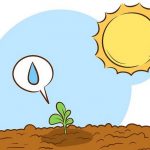 Donations to upgrade EatTheWeeds.com and fund a book have gone well and made it past the half way mark. Thank you to all who have contributed to either via the Go Fund Melink, the PayPal donation link or by writing to Green Deane POB 941793 Maitland FL, 32794. There are many needs left such as expanding the foraging teacher page and the page on monotypic edibles. Several functions were also lost when we transitioned to the new website. There’s always something and such things get more complex and expensive every year.
Donations to upgrade EatTheWeeds.com and fund a book have gone well and made it past the half way mark. Thank you to all who have contributed to either via the Go Fund Melink, the PayPal donation link or by writing to Green Deane POB 941793 Maitland FL, 32794. There are many needs left such as expanding the foraging teacher page and the page on monotypic edibles. Several functions were also lost when we transitioned to the new website. There’s always something and such things get more complex and expensive every year.

Green Deane Forum
Want to identify a plant? Need to identify a plant? Looking for a foraging reference? Maybe you have a UFO, an Unidentified Flowering Object, you want identified. On the Green Deane Forum we — including Green Deane — chat about foraging all year. And it’s not just about warm-weather plants or just North American flora. Many nations share common weeds so there’s a lot to talk about. There’s also more than weeds. The reference section has information for foraging around the world. There are articles on food preservation, and forgotten skills from making bows to fermenting food. Recent topics include: I Finally Found Wapato, Looks like Corn, Weed With Pod At Top, A Mile Walk In The Woods, Chicken of the Woods?, Elderberry Fungus, Spurge Nettle 2018, Does Anybody Know This Berry, and Five-Minute “English” Muffin with Beautyberries. You can join the forum by clicking on the button in the menu line.
This is weekly issue 325.
If you would like to donate to Eat The Weeds please click here. Or you can use my Go Fund Me link, or by writing to Green Deane POB 941793 Maitland FL, 32794

